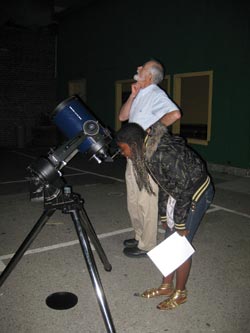Ask these Girl Scouts how they spent their summer vacation, and you’ll hear about video games. But they didn’t spend the summer playing them – they spent it making them.
A group of 22 sixth- to 10th-grade Girl Scouts at ASA Academy & Community Science Center in West Oakland, Calif., worked this summer to create online games in an immersive 3-D “in world” setting and, in the process, learned about technology, astronomy and global networking.
One goal of the pilot after-school and summer program “Universe Quest” is to seek out the talents and interests of girls in socioeconomic groups that traditionally don’t pursue careers in science and technology. “Its main mission is to inspire girls to build a personal connection with science and technology using astronomy and game development, while empowering them with the skills they need to succeed in their education and life,” said Heather Vilhauer, Universe Quest program manager at Girl Scouts of Northern California. Girls in middle school tend to thrive in all-girl educational environments, and this program allows them to explore science in a new and exciting way, she added.
The program represents collaboration between the Space Sciences Laboratory at the University of California, Berkeley, the Girls Go Tech program of Girl Scouts of Northern California and the Astronomical Society of the Pacific. The project is made possible by a $1.5 million National Science Foundation Innovative Technology Experiences for Students and Teachers (ITEST) grant to the University of California, Berkeley.
Through the game creation process, the girls are introduced to careers in areas such as software development and information technology. Creating the games helps them gain scientific knowledge, confidence in using technology, and soft skills such as teamwork, said Carl Pennypacker, UC Berkeley principal investigator of the Universe Quest project.

Girls get hands-on experience with telescopes as part of the pilot “Universe Quest” program, which enables them to author games in a 3-D virtual setting while learning about astronomy, technology and global networking. Photo courtesy of Heather Vilhauer.
The program welcomed approximately 15 girls last spring and will have up to 40 participants this year, when it will be held at two sites in Oakland, Vilhauer said. She added that the team is currently developing a formal curriculum for the two-year program, which will be available online to the general public. “We would like to see after-school programs from around the world adopt this program and use it as an opportunity to expand girls’ interest in science and math,” she said.
The games are not available online. This year girls in Oakland will be piloting their games by sharing them with girls in Portugal and Kenya.
Learning in the world
The Universe Quest games allow girls to put characters, objects, characters’ paths and questions together so that a player learns something before advancing to the next level, according to Pennypacker who is also an astrophysicist at the University of California, Berkeley, and the Lawrence Berkeley National Laboratory. There eventually will be a “leveling up” system where, when students get correct answers, they can have access to new resources, such as a remote robotic telescope, he said.
The Universe Quest game uses the Thinking Worlds 3-D game authoring engine, but the project has added a lot of custom features.
As part of the program, the girls are learning how to operate telescopes remotely from their computers. Online, for example, they can point these devices at celestial objects and take exposures. The project shares ownership of a remote telescope with Perth Observatory in Australia and makes use of Frank Pino’s Ironwood North Observatory in Queen Creek, Ariz., and the Tzec Maun Foundation Internet telescope.
With the online assistance of Lech Mankiewicz, an astrophysicist in Warsaw, Poland, educator Susan Murabona of Nairobi, Kenya, captured images of galaxy M51 remotely using Pino’s telescope and shared them online with the girls in California. These images will become part of the game framework. The girls are also learning about simple optics and will build their own simple “Galileoscope.”
Image processing
The girls’ image processing experience might involve measuring the moons of Jupiter and the planet’s mass from the orbits found in successive pictures. Or it might involve measuring the brightness of asteroids as they rotate and reflect varying amounts of sunlight, Pennypacker said. The girls use the SalsaJ image processing software, which sits on top of National Institutes of Health’s ImageJ medical software.
Pennypacker said that Universe Quest girls will be linked to mentors in the industry and that project leaders also work with local programs to bring in role models in the fields of astronomy and technology to share the successes and challenges of their careers.
Linking the project to activities in the classroom has been easy, he added. “Simply put, the girls love authoring games, they love the astronomy, and they love making learning challenges within the games to teach other girls,” Pennypacker said.